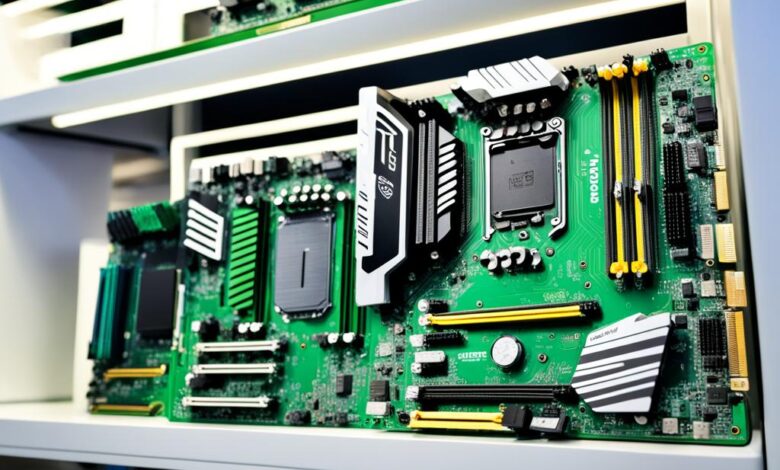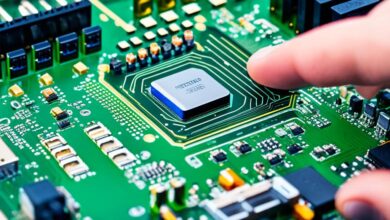
When you build a computer or upgrade one, the motherboard is key. It sets performance and capabilities. Ever thought about the cost? This guide looks into motherboard costs. It helps you understand prices and make good choices.
Prices for motherboards can range greatly. They start at $50 for basic types. But, high-end options can go over $500. Many things affect a motherboard’s price. The chipset, socket type, and form factor matter a lot. Also, expansion capabilities and features add to the cost.
Unraveling the Mystery of Motherboard Pricing
Learning about what makes motherboard prices change is key for smart buying choices. Prices of motherboards can differ a lot. So, it’s important to know what makes them worth more or less.
What Factors Influence the Cost?
Many things make a motherboard cost more or less. Here are some of the big ones:
- Chipset and socket type: The motherboard’s chipset and socket compatibility with the CPU can significantly impact the overall cost.
- Form factor: The size and layout of the motherboard, whether it’s ATX, Micro-ATX, or Mini-ITX, play a role in pricing.
- Memory support: The motherboard’s ability to accommodate different memory types and capacities can influence its value.
- Expansion slots: The number and types of expansion slots, such as PCIe and M.2, contribute to the motherboard’s cost.
- Integrated features: Motherboards with advanced integrated features, like high-quality audio, networking, and storage controllers, tend to be more expensive.
Understanding the Components That Drive Value
Getting to know the parts that really make a motherboard valuable can help us better understand prices. Let’s look at these important factors:
| Component | Impact on Motherboard Value |
|---|---|
| Chipset | The chipset determines the motherboard’s overall performance and features, with higher-end chipsets typically commanding a premium price. |
| Socket Type | The socket type must match the CPU you plan to use, and motherboards with more advanced socket types often cost more. |
| Memory Support | Motherboards that support higher memory speeds and capacities, such as DDR4 or DDR5, can be more expensive. |
| Expansion Slots | The number and types of expansion slots, including PCIe and M.2, can influence the motherboard’s price, as more slots generally mean higher costs. |
| Integrated Features | Motherboards with advanced integrated features, like high-quality audio, networking, and storage controllers, tend to be more expensive but offer enhanced functionality. |
Understand what makes motherboard prices go up or down by looking at the components that determine motherboard value. This knowledge helps when you’re choosing a motherboard that fits your needs and budget.
Chipset and Socket: The Foundation of Performance
In the motherboard world, the chipset and socket are vital. They set the base for how well your computer works. These parts greatly influence what a motherboard can do and its cost.
The chipset serves as the brain for your PC. It handles how the CPU, memory, and more talk to each other. A chipset’s features decide what kind of CPU and memory you can use, the number and kind of slots for upgrades, and what extra features you get. The top-tier chipsets, like Intel’s Z-series or AMD’s X-series, offer the best abilities but cost more.
The socket links the CPU and motherboard together. It’s a physical connector. Its type and version determine which CPUs fit and work with the motherboard. So, the socket also plays a part in the overall performance and price of your computer. A motherboard with an older socket might be cheaper but will only work with older, less powerful CPUs.
It’s key to grasp how the chipset and socket affect a motherboard’s value. Better chipsets and sockets mean better performance but they are more expensive. Figuring out your needs and balancing what you pay with what you get is crucial. This strategy can help you pick a great motherboard without overspending.
When all is said and done, chipsets and sockets are crucial for your computer’s performance. Knowing their impact on a motherboard’s price and abilities helps you choose wisely. You can find the best motherboard for your next PC by keeping these key parts in mind.
Form Factor: Finding the Perfect Fit
Motherboards come in different sizes, called form factors. Each one affects the cost. By knowing about ATX, Micro-ATX, and Mini-ITX, you can choose right for your needs and wallet.
ATX, Micro-ATX, and Mini-ITX Explained
The motherboard’s form factor is its size and layout. This affects what you can do with your computer. Let’s explore ATX, Micro-ATX, and Mini-ITX:
- ATX: This big standard size, measuring 12 inches by 9.6 inches. ATX boards are great for adding extra parts and power, making them a top choice for gaming PCs.
- Micro-ATX: A bit smaller than ATX, at 9.6 inches by 9.6 inches. They’re perfect if you want parts packed a bit tighter but still need good power and flexibility.
- Mini-ITX: The tiniest, at just 6.7 inches by 6.7 inches. Mini-ITX is for small builds like home theaters. They offer less but cost less too.
Your build’s cost changes with the motherboard size. Bigger boards cost more but offer more features. So, ATX boards are on the high end, and Mini-ITX is more budget-friendly.
| Form Factor | Dimensions (inches) | Expansion Slots | Memory Channels | Typical Price Range |
|---|---|---|---|---|
| ATX | 12 x 9.6 | Up to 7 | Up to 4 | $80 – $300+ |
| Micro-ATX | 9.6 x 9.6 | Up to 4 | Up to 2 | $60 – $200 |
| Mini-ITX | 6.7 x 6.7 | Up to 1 | Up to 2 | $50 – $150 |
Knowing about different motherboard sizes helps you pick one that fits your needs and your budget.
How Much is a Motherboard: Navigating the Price Spectrum
Building a new computer means picking the right motherboard. This part is crucial and can affect your total spending a lot. Motherboard prices vary from low-cost to expensive models. Knowing what makes a motherboard expensive can help you choose wisely within your budget.
Prices can start from as low as $50 for simple models. They can go as high as over $500 for those with many features. The cost depends on things like the chipset, socket, and memory support. Also, the size, expansion slots, and extra features play a big role.
If a motherboard has the latest chipset tech, it might be pricier. The same goes for models that support new types of memory or allow for better performance with overclocking.
It’s important to balance what you need with what you can spend. While a more expensive motherboard might do more, cheaper ones are still good for most people. You just need to think about what you want your computer to do. This will help you focus on the features that matter most for your use.
We have a complete guide to help you understand motherboard prices. We cover what you should look for to get the best value. With our help, you can find the right motherboard for your computer without overspending.
Memory Support: Maximizing Your Multitasking Potential
Choosing the right motherboard involves looking at its memory support. The memory type, like DDR4 or DDR5, affects the motherboard’s price. We’ll look at how DDR4 and DDR5 differ and what that means for your system’s cost.
DDR4 vs. DDR5: What’s the Difference?
DDR4 and DDR5 are the newest types of memory for your system. DDR4 has been around for years, offering steady performance at an affordable price. DDR5, however, is the new high-speed option, with greater efficiency and bigger capacity.
Here are the main points that set DDR4 and DDR5 memory apart:
- DDR5 is faster, hitting speeds up to 6,400 MT/s, compared to DDR4’s 2,666 to 3,200 MT/s.
- DDR5 has higher bandwidth, making data transfer between the CPU and memory more efficient.
- DDR5 modules can hold up to 128GB, doubling DDR4’s 64GB maximum capacity.
- DDR5 uses less power, which can help your system run cooler and more efficiently.
These DDR5 benefits do come with a higher price compared to DDR4. But, the cost gap is likely to shrink as more DDR5 becomes available.
The decision between DDR4 and DDR5 depends on your needs and budget. If you want the best performance and to be ready for the future, DDR5 might be better. For those budget-focused, DDR4 still brings good multitasking features and value.
Expansion Slots: Future-Proofing Your Build
Building a new computer is exciting. The motherboard and its expansion slots are key. They impact your system’s future possibilities. We’ll show you why they matter and how they relate to cost.
Expansion slots are the secret to adding more to your PC. Things like graphics cards and network adapters fit into them. The more slots the motherboard has, the better you’re set for later upgrades. So, think ahead when choosing.
The variety and number of slots can raise a motherboard’s price. If it supports new tech like PCIe 4.0, it might cost more. That’s because these features use intricate and costly parts. But, these options offer more future possibilities for your PC.
Think about what you need now and might need later. If you plan to add more parts in the future, choose a motherboard with many slots. It might be a bit pricier at first. Yet, it can save you more than it costs later on by avoiding a full motherboard swap.
| Expansion Slot Type | Typical Use Cases | Impact on Motherboard Price |
|---|---|---|
| PCIe x16 | High-performance graphics cards | Significant impact, as more PCIe x16 slots increase the overall cost |
| PCIe x1 | Sound cards, network adapters, and other low-profile expansion cards | Moderate impact, as additional PCIe x1 slots add to the motherboard’s complexity and cost |
| M.2 slots | High-speed storage (SSDs) and wireless network adapters | Moderate impact, as more M.2 slots increase the motherboard’s feature set and price |
Knowing how expansion slots affect your computer’s price is key. It helps you pick the best motherboard for your budget and needs. With the right knowledge, you can future-proof your PC wisely while managing your spending.
Integrated Features: Enhancing Functionality
Motherboards come with built-in features like audio and networking. These help make your computer better, but they also affect the price. Knowing how these features influence the cost can guide you to the best choice.
Audio, Networking, and More
Motherboards often have good audio setups built in. This is great for anyone who loves music or makes videos. They also include networking features, like Wi-Fi and Ethernet, saving you from buying extra cards and extra cash.
Storage features on motherboards make setting up storage easier. You’ll find things like SATA ports and M.2 slots. These can lower your spending and simplify setting up your computer.
| Integrated Feature | Impact on Motherboard Price |
|---|---|
| High-quality Audio Chip | Adds $20-$50 to the motherboard’s cost |
| Dedicated Ethernet Port | Adds $10-$30 to the motherboard’s cost |
| Wireless Wi-Fi Module | Adds $20-$60 to the motherboard’s cost |
| Multiple SATA Ports | Adds $5-$15 to the motherboard’s cost |
| M.2 Slot for SSD | Adds $10-$30 to the motherboard’s cost |
It’s crucial to understand how these features affect the price. This way, you can focus on what matters most and balance your budget with performance wisely.
Brand Reputation: Balancing Quality and Cost
The name of the brand you choose greatly affects the price of motherboards. It’s key to understand how a brand’s image can change the cost for you. Looking into the brand’s quality and how they support customers can guide you. It helps in finding a good mix of performance, features, and what you can afford.
Brands known for being reliable and high-quality often charge more for their motherboards. They spend a lot on research and development to ensure their products are top-notch. People often choose to pay more for these brands for the peace of mind. They’re confident they’re buying something that will work well and last long.
Yet, there are also brands that are not as well-known or focused on offering budget-friendly options. These might look appealing due to their lower prices. But it’s wise to check the brand’s reputation and read what customers say about them. Plus, think about what you might be giving up in terms of how the motherboard performs, its features, and how long it will last.
To aid you in walking this tightrope, we’ve created a table. It shows how a brand’s reputation can change a motherboard’s cost:
| Motherboard Brand | Average Price Range | Perceived Quality | Customer Support |
|---|---|---|---|
| ASUS | $150 – $500 | High | Excellent |
| MSI | $100 – $400 | High | Good |
| Gigabyte | $80 – $350 | Moderate | Average |
| ASRock | $70 – $250 | Moderate | Average |
Understanding the relationship between motherboard brand reputation and price can guide you in making a smart choice. Keep in mind that the brand influences the price. But choosing the best value for your needs is up to you.
Overclocking Capabilities: Unleashing Hidden Performance
Technology is always getting better. Many motherboards now let you overclock. This means you can make your computer work faster by adjusting its settings. Overclocking can boost your computer’s speed. But, it might cost more since motherboards with good overclocking can be pricier.
Is It Worth the Investment?
Deciding to buy an overclocking motherboard depends on what you need. If you love gaming or make a lot of content, it could be a good buy. It lets you make your computer faster, improving things like frame rates and how quickly your computer makes images.
But, overclocking has some downsides. It might use more power, make more heat, and possibly wear out your computer quicker. To help with these problems, high-end motherboards have better power and cooling tech. Yet, if you’re not into the tech side of overclocking or you don’t need your computer to be the very best, a cheaper motherboard might be better for you.
If you’re all about getting the most performance out of your computer, a motherboard that’s good for overclocking could be worth the extra cost. But, if you just want your computer to run well without dealing with extra tech, a regular motherboard should do.
Conclusion: Striking the Right Balance
Choosing a motherboard is about finding that sweet spot. We balance what we need, our budget, and the key features. This is true whether we’re making a top-tier gaming PC or a simple work computer.
So, how to choose the right motherboard? Think about the chipset, form factor, and memory support. Also, consider the expansion slots and built-in features. By focusing on these, our motherboard will fit our needs now and in the future.
Picking a motherboard means looking at more than the cost. We need to balance performance, how it fits with other parts, and the price. This way, we can get the perfect motherboard without spending more than we should. With these tips, we’re ready to wisely invest in our PC’s core part.





